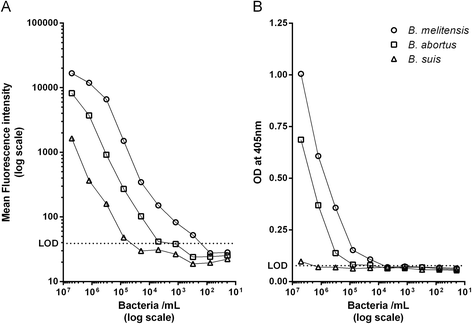Development of a bead-based Luminex assay using lipopolysaccharide specific monoclonal antibodies to detect biological threats from Brucella species
- PMID: 26438077
- PMCID: PMC4595103
- DOI: 10.1186/s12866-015-0534-1
Development of a bead-based Luminex assay using lipopolysaccharide specific monoclonal antibodies to detect biological threats from Brucella species
Abstract
Background: Brucella, a Gram-negative bacterium, is classified as a potential bioterrorism agent mainly due to the low dose needed to cause infection and the ability to transmit the bacteria via aerosols. Goats/sheep, cattle, pigs, dogs, sheep and rodents are infected by B. melitensis, B. abortus, B. suis, B. canis, B. ovis and B. neotomae, respectively, the six classical Brucella species. Most human cases are caused by B. melitensis and B. abortus. Our aim was to specifically detect Brucellae with 'smooth' lipopolysaccharide (LPS) using a highly sensitive monoclonal antibody (mAb) based immunological assay.
Methods: To complement molecular detection systems for potential bioterror agents, as required by international biodefense regulations, sets of mAbs were generated by B cell hybridoma technology and used to develop immunological assays. The combination of mAbs most suitable for an antigen capture assay format was identified and an immunoassay using the Luminex xMAP technology was developed.
Results: MAbs specific for the LPS O-antigen of Brucella spp. were generated by immunising mice with inactivated B. melitensis or B. abortus cells. Most mAbs recognised both B. melitensis and B. abortus and antigen binding was not impeded by inactivation of the bacterial cells by γ irradiation, formalin or heat treatment, a step required to analyse the samples immunologically under biosafety level two conditions. The Luminex assay recognised all tested Brucella species with 'smooth' LPS with detection limits of 2×10(2) to 8×10(4) cells per mL, depending on the species tested. Milk samples spiked with Brucella spp. cells were identified successfully using the Luminex assay. In addition, the bead-based immunoassay was integrated into a multiplex format, allowing for simultaneous, rapid and specific detection of Brucella spp., Bacillus anthracis, Francisella tularensis and Yersinia pestis within a single sample.
Conclusion: Overall, the robust Luminex assay should allow detection of Brucella spp. in both natural outbreak and bio-threat situations.
Figures




Similar articles
-
[Highly sensitive enzyme-linked assay based on monoclonal antibodies for detection of Brucella antigens].Zh Mikrobiol Epidemiol Immunobiol. 2007 Jan-Feb;(1):52-7. Zh Mikrobiol Epidemiol Immunobiol. 2007. PMID: 17523430 Russian.
-
A repA-based ELISA for discriminating cattle vaccinated with Brucella suis 2 from those naturally infected with Brucella abortus and Brucella melitensis.Mol Cell Probes. 2014 Oct-Dec;28(5-6):251-4. doi: 10.1016/j.mcp.2014.06.002. Epub 2014 Jun 15. Mol Cell Probes. 2014. PMID: 24941369
-
Development of a colloidal gold immunochromatographic test strip for detecting the smooth Brucella.Sci Rep. 2024 Oct 23;14(1):25068. doi: 10.1038/s41598-024-76026-4. Sci Rep. 2024. PMID: 39443541 Free PMC article.
-
Brucella melitensis infection in sheep: present and future.Vet Res. 1998 May-Aug;29(3-4):255-74. Vet Res. 1998. PMID: 9689741 Review.
-
Fluorescence polarization assay for the diagnosis of brucellosis: a review.J Immunoassay Immunochem. 2001;22(3):183-201. doi: 10.1081/IAS-100104705. J Immunoassay Immunochem. 2001. PMID: 11506271 Review.
Cited by
-
Establishment of a Molecular Serotyping Scheme and a Multiplexed Luminex-Based Array for Enterobacter aerogenes.Front Microbiol. 2018 Mar 19;9:501. doi: 10.3389/fmicb.2018.00501. eCollection 2018. Front Microbiol. 2018. PMID: 29616012 Free PMC article.
-
Simultaneous Immunodetection of Anthrax, Plague, and Tularemia from Blood Cultures by Use of Multiplexed Suspension Arrays.J Clin Microbiol. 2018 Mar 26;56(4):e01479-17. doi: 10.1128/JCM.01479-17. Print 2018 Apr. J Clin Microbiol. 2018. PMID: 29386263 Free PMC article.
-
A multiplex liquid-chip assay based on Luminex xMAP technology for simultaneous detection of six common respiratory viruses.Oncotarget. 2017 Jun 17;8(57):96913-96923. doi: 10.18632/oncotarget.18533. eCollection 2017 Nov 14. Oncotarget. 2017. PMID: 29228581 Free PMC article.
-
Impact of Aerosol Dust on xMAP Multiplex Detection of Different Class Pathogens.Front Microbiol. 2017 Nov 29;8:2341. doi: 10.3389/fmicb.2017.02341. eCollection 2017. Front Microbiol. 2017. PMID: 29238328 Free PMC article.
-
Immunological pathways of macrophage response to Brucella ovis infection.Innate Immun. 2020 Oct;26(7):635-648. doi: 10.1177/1753425920958179. Epub 2020 Sep 24. Innate Immun. 2020. PMID: 32970502 Free PMC article.
References
-
- Centers for Disease Control and Prevention. Emergency Preparedness and Response. Specific Hazards. Bioterrorism. http://www.bt.cdc.gov/bioterrorism. Accessed 9 Sept 2013.
-
- Corbel MJ. Brucellosis in humans and animals. WHO. 2006.
Publication types
MeSH terms
Substances
LinkOut - more resources
Full Text Sources
Other Literature Sources
Medical
Molecular Biology Databases
Miscellaneous

